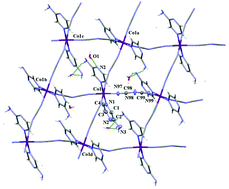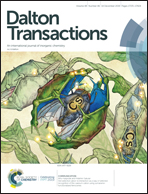Influence of the pyrazine substituent on the structure and magnetic properties of dicyanamide-bridged cobalt(ii) complexes†
Abstract
Substituted pyrazines were successfully used to prepare two new coordination polymers of formulas {[Co(dca)2(NH2pyz)2]·H2O}n (1) and [Co3(dca)6(HOpyz)5(H2O)2]n (2) [dca = dicyanamide, NH2pyz = 2-aminopyrazine and HOpyz = 2-hydroxypyrazine] whose structures were determined by single-crystal X-ray crystallography. The structure of 1 consists of a two-dimensional rhombus grid of cobalt(II) ions where the dca ligand adopts the μ1,5 bridging mode with trans-positioned monodentate NH2pyz molecules completing the six-coordination around each metal ion. Compound 2 exhibits a stair-like two-dimensional structure where the intralayer connections are performed by the dca and HOpyz groups exhibiting μ1,5 and bis-monodentate coordination modes, respectively. The values of the cobalt–cobalt separation through the dca bridges are 8.2107(3) (1) and 8.4746(4) and 8.5249(4) Å (2) whereas the value through the hydroxypyrazine is 7.2052(6) Å (2). Solid-state direct-current magnetic susceptibility analyses in the temperature range of 1.9–300 K for 1 and 2 reveal the occurrence of magnetically isolated high-spin cobalt(II) ions with a significant contribution to the magnetic moment (1 and 2), D = +95.4 (1) and +76.5 cm−1 (2) and the antiferromagnetically coupled pairs of cobalt(II) centres through the bis-monodentate 2-hydroxypyrazine, J = −0.3 cm−1 (2). Both compounds exhibit frequency dependence of the out-of-phase alternating current (ac) magnetic susceptibility (χ′′M) under non-zero applied dc fields, a feature which is characteristic of single-ion magnet behaviour (SIM). Q-band EPR studies on the polycrystalline samples of 1 and 2 at low temperatures confirm the positive sign of D and reveal the occurrence of a strong asymmetry in the g-tensors. Theoretical calculations by CASSCF/NEVPT2 support these results. An analysis of the dynamic behaviour of 1 and 2 suggests that the relaxation of the magnetization occurs in the ground state under applied fields through two Orbach processes possibly bound to low-lying vibrational modes in the high temperature range, and to the slowing down of the fast interconversion between the two contributions of the ground Kramers doublet at lower temperatures induced by the applied dc field.



 Please wait while we load your content...
Please wait while we load your content...